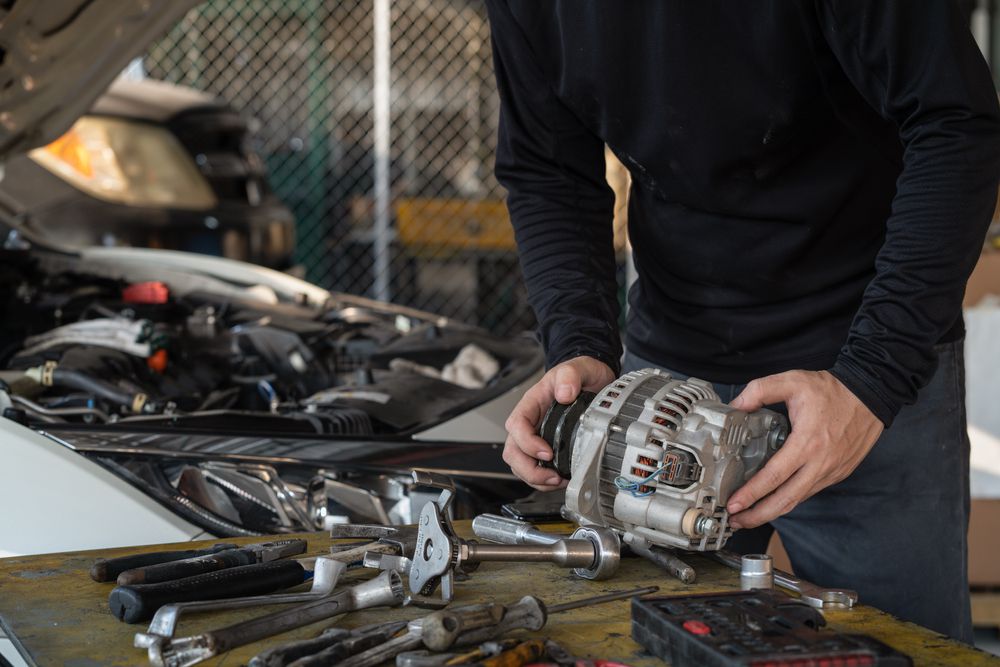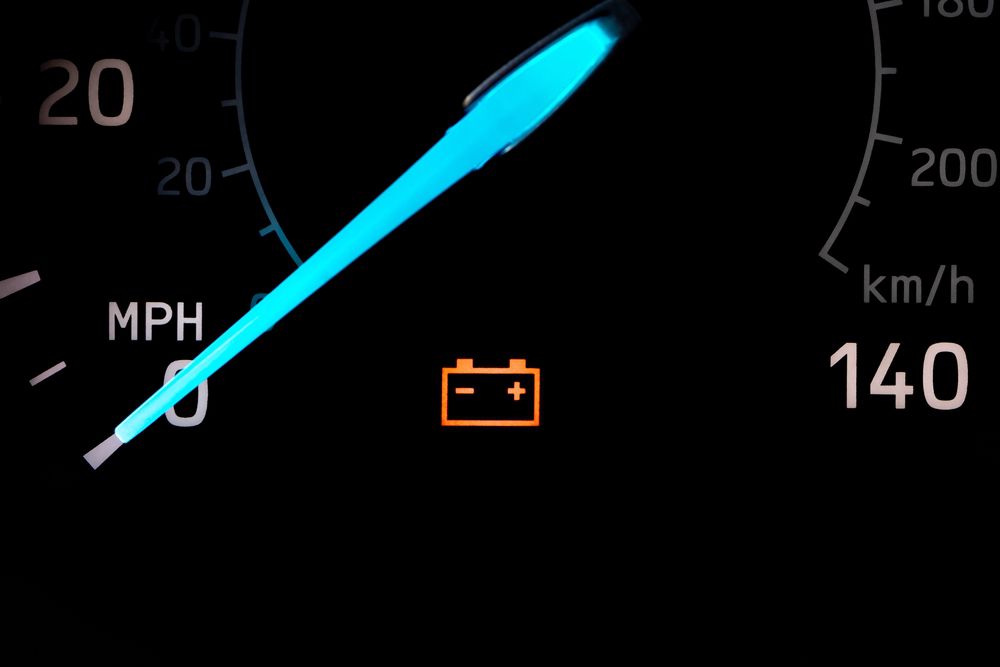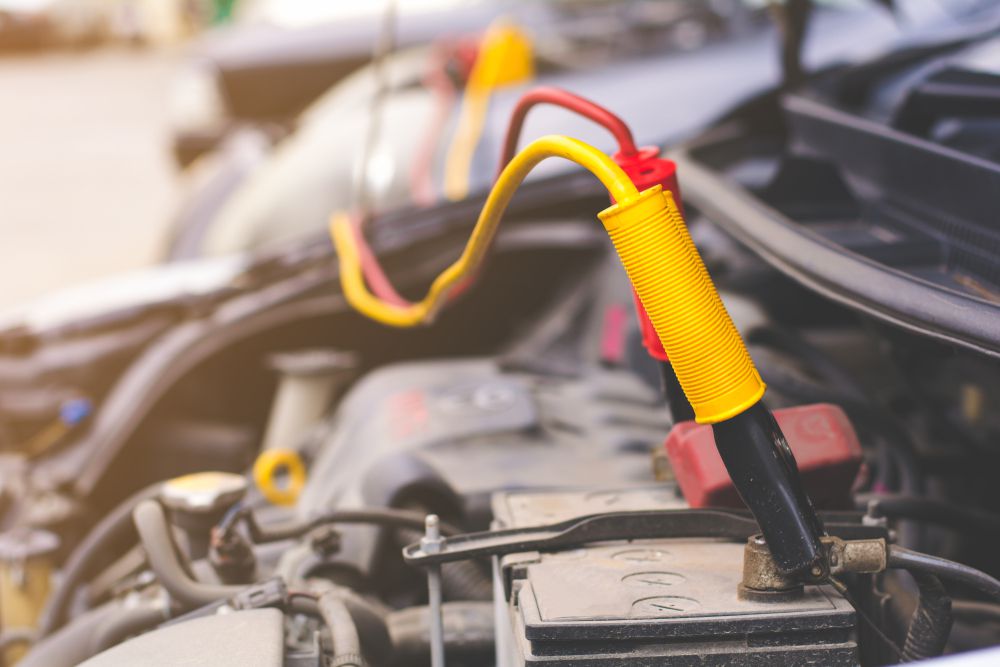The alternator converts mechanical energy from the engine into electrical
energy that keeps the vehicle's battery charged and powers the car's
electrical components and accessories.
A car without an alternator will only go as far as the battery can
power it, typically at a maximum range of around 25 miles or 40
kilometers. However, the range will likely be as low as 2 or 3 miles.
After that, the battery won't have enough charge to power the car's
electrical components, and the car will stall.
A failing alternator will leave you stranded, so if you know your
alternator is not functioning properly, pulling over to a safe spot as soon
as possible if you're driving is important.
This article will discuss how long a car will run once the alternator
fails.
 A mechanic replacing an alternator.
A mechanic replacing an alternator.
How Far Can I Drive with a Dead Alternator?
Without an alternator, your car will have to rely on the battery for
its electrical energy. Depending on the size and quality of the
battery, it'll be able to keep the car running for up to 25 miles of
travel on a full battery.
The car alternator converts mechanical energy into usable electric energy
in the form of an alternating current and is what keeps your vehicle's
battery fully charged.
The fully charged battery provides the power to the vehicle's starter,
which gives the engine its first few rotations to get it started before the
combustion process takes over.
This charging system provides energy to the battery, which oversees
numerous important operations that make your car's electrical components
work.
Along with providing power to the vehicle's ignition system, the battery is
also important in managing other components, such as the lights, drive
belt, radio, ignition, power windows, and headlights—the battery manages
even your heated seats.
With a failing alternator, less battery life translates to less travel
time. If the battery cannot supply alternating current to the car's engine,
the car will not start. If your alternator breaks down, you might begin to
experience the following symptoms:
-
The alternator warning light
-
Dim or overbright lights
-
Whining or growling noises
-
Burning or rubbery smells
-
A faulty belt
-
Stalling or difficulty starting
It's important to note that these issues can sometimes arise as a result of
other problems in your car.
Still, a combination of any of these problems generally indicates that
there's something wrong with your alternator.
Most cars will go between 80,000 and 100,000 miles before the alternator
needs to be repaired or replaced.
 A bad alternator will quicky lead to a dead battery.
A bad alternator will quicky lead to a dead battery.
Can I Drive My Car If the Alternator Is Not Working?
You may be able to drive a few miles with an alternator that is not working
correctly, but it is hazardous.
There is a high probability that a malfunctioning alternator will leave you
stranded.
Usually, when your alternator fails and the battery begins to drain, you
may notice your headlights and dash lights may start to flicker.
Once the battery dies, there's nothing to power the car's electrical
systems, and your vehicle will stall. However, you'll probably see the
battery light turn on before this happens, indicating that the electrical
systems are about to shut down.
Make sure to get the car alternator looked at by a professional mechanic as
soon as you suspect any problems. Testing a battery and alternator is a
simple process and shouldn't take long or cost much money.
The mechanic will recommend the next course of action; however, it is
usually the most cost-effective to replace the alternator rather than
repair it.
How Long Will a Car Battery Last If the Alternator Is Not Working?
How long the battery lasts with an alternator that isn't working depends on
its size, age, and quality, but it won't be long.
It will most likely be a few minutes before you start to notice the battery
going dead, so it's essential to get your vehicle parked safely as soon as
possible.
Modern cars have a sensor that will trigger when the alternator is not
producing enough voltage, which is a surefire sign that you should bring it
to the shop immediately.
Before you see this warning sign, you should look for electrical faults
like flickering lights, dimming, or other malfunctioning electrical
systems.
The alternator is responsible for providing power to the battery for these
systems. If you have a bad alternator, your car's battery will suffer, and
these electrical functions will be faulty.
 Charging a dead battery.
Charging a dead battery.
How Far Can You Drive on a Full Battery without an Alternator?
If you are sure your battery is full, you may be able to drive up to 25
miles without an alternator, but it heavily depends on the type of vehicle
and battery. So instead, you should only expect to go 2 - 3 miles before
experiencing problems.
If you suspect a problem with your alternator, getting your vehicle into a
shop for diagnostic testing ASAP is safest.
It's always better to catch problems with the alternator in your car before
it becomes a hazard to you on the road.
How Much Does It Cost To Fix An Alternator
Replacing an alternator can cost anywhere from $500 to $1000, depending on
the make, model, and location of the repair.
Rebuilds may be cheaper, with the cost of the rebuild itself running
anywhere from $70 to $120. The labor also comes with a cost of $80 to $120.
Final Thoughts
A car with a bad alternator is not suitable to drive.
If you manage to get a car with a bad alternator started, you won't be able
to drive very far before the battery dies and the car stalls leaving you
stranded.
The absolute farthest distance you can expect to drive without an
alternator is 25 miles, however, it's much more likely you'll only be drive
2 - 3 miles before the car's electrical system starts malfunctions and the
car dies.
Ironically, in an older, pre -ECU vehicle, you may get further than in a
newer car because the charging system was used for much fewer operations
within the vehicle, instead relying on vacuum and mechanically actuated
devices.